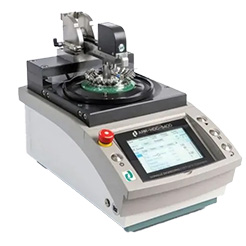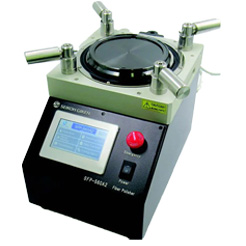Maximize Polishing Precision, Efficiency and Return on Investment
Many polishing machines are capable of polishing connectors, single fiber or multi fiber (MT) ferrules however there is a substantial difference between the various polishing machines available in the marketplace. At Fiber Optic Center we’ve experienced many different polishing machines from various equipment manufacturers over the last three decades and learned how to extract superior performance on connectors and ferrules with complementary products such as ÅngströmLap® films and ÅngströmBond® epoxies. Simplifying assembly procedures and implementing semi-automated equipment and tools to eliminate operator independence helps our customers to lower the assembly cost. The Fiber Optic Center technical team continuously communicates our needs with our strategic vendors for product improvement to enable our customers to lead the market on performance and cost.
Fiber Optic Center is the preferred technical distributor for leading polishing machine manufacturers such as Domaille Engineering and Seikoh Giken. We are known by our customers and vendors for our total solution support. We support our customers with installation, instruction and training anywhere in the world to ensure that our customers produce the best cable assemblies at the lowest cost.
Equipment Selection Process
Before selecting equipment, we typically communicate with our customers about their business objectives, operations, strategies and opportunities. Important details include which type of cable assemblies are required to be assembled, the complexity of the assembly, the handling of cabling, the preferred connector manufacturers, the required production capacity, the cost drivers, the existing brands and type of equipment, the actual technical and cost challenges and more. From this conversation, we are able to provide a neutral perspective on available types of equipment and the expected performance, capacity and cost.
Comparing multiple options is helpful in the selection process. Where traditionally polishing machines from Seikoh Giken were chosen on price and performance for high-volume single fiber connectors, Domaille Engineering also offers high-capacity fixtures that enable operators to polish up to 72 LC connectors at the same time.
When it comes to polishing stability (geometry control), especially on tighter specified single fiber SC/APC connectors with heavy-duty cables, which are used in Fiber to The Home (FTTH) applications, we do see the advantage of using the polishing fixtures with fixed adapters versus spring loaded or Independent Pressure Control (IPC) adapters. The weight and side-pull force of the cable influences the spring counterforce negatively causing more connectors to fail on geometry tests thus increasing production cost. The re-work of products that are out of specification is often an under-estimated issue and could become a real cost driver reducing production output.
Both Domaille Engineering and Seikoh Giken continuously upgrade their polishing platforms to increase the required polishing pressure as more MT ferrules (up to 24) are polished at the same time. Where Domaille Engineering traditionally leads the market for multifiber polishing with their established APM-HDC-5000 series (over 20 years), Seikoh Giken introduced their SFP-560 platform which now also has adjustable fixture pressure control.
As loading and unloading of MT ferrules is a critical procedure, smarter clamping styles are introduced, both at Seikoh Giken and Domaille Engineering, eliminating the need for torque-controlled screwdrivers.
Contamination Control Conversations
Cleaning in between polishing steps is extremely important to avoid cross-contamination between the polishing steps. With MT(P) and MPO connectors, where the polishing process is very different than single fiber connectors, it is more critical than ever before to clean the ferrules, polishing plate and films. Equipment manufacturers have developed their own washing and cleaning stations due to cleaning being a critical part of the polishing process. Additionally, there are washing stations used by the operators to dose the correct amount of distilled water for the polishing films prior to polishing.
Lapping Film Considerations
The polishing films required for MT(P) MPO polishing process are very different to the films that are used for single-fiber zirconia ferrules. As MT ferrules consist of glass-filled polymer material with an embedded array of fibers, the challenge is to have all fibers protrude at the same length for physical contact between all fibers in the interconnect. The polishing process, Chemical Mechanical Edging (CMP), is designed to edge the polymer material while the fibers remain in shape, resulting in a controlled uniform protrusion of the fiber array.
It's often underestimated that this polishing process requires precision leveling with all fibers in the array. The IEC/Telcordia specifications require that the fibers protrude between 1000-3000nm from the ferrule surface while the non-coplanarity over all fibers should be maximum 300nm. The challenge of different connector, ferrule and fiber manufacturers requires precision control to meet these geometrical requirements. The polymer material differs from each manufacturer. For this reason, Domaille Engineering developed the option to reverse the direction of the rotation platen in their latest model APC-HDC-5400.
Looking at the fiber itself, we also see different manufacturers and type of fibers that offers more bandwidth. Multimode multifiber (MT) are most common in the industry and changed from core diameter 62.5um to 50um determined in the industry standards OM1, OM2, OM3, OM4 and OM5. The transceivers transmitting higher data rates and need clear eye-patterns to detect the digital signal. Fibers are designed to transmit less modes (more singlemode) to minimize time delay. Because interconnect reflections can cause a delay, the industry requires the best optical reflection values, far beyond the traditional IEC/Telcordia standard. Today multimode multifiber interconnects are flat polished (PC). We see now that multifiber interconnects are also angled polished. APC ferrules are the standard used in the MMC interconnect, from USConec, to reduce the optical reflections for higher data rates in future applications.
Increasing Bandwidth of Data Transmission
Fiber manufacturers participate also in this bandwidth era and continuously develop different core and cladding structures to increase the bandwidth of data transmission. We noticed that fiber cores are made of softer glass than the cladding which influences the geometry of the fiber tip during polishing. This phenomenon where the fiber tip is flatter at the top is known as core dip and can cause less physical contact between fiber cores in a connection resulting in more reflections. This is undesirable for higher data transmission. With optimal geometrical stability and advanced polishing processes, we are able to achieve exceptional fiber uniformity control and eliminate core-dip resulting in the best optical measurements value. FOC customers benefit from this complete process knowledge during selections as they successfully produce the high-quality cable assemblies at the lowest cost.
At Fiber Optic Center we can help you making that decision on all aspects of the assembly line. This includes the smallest details such as tools, consumables (epoxies, lapping film and cleaning), production and test & measurement equipment avoiding any discussion between the individual vendors in case the desired performance can’t be achieved. Fiber Optic Center is your partner.





